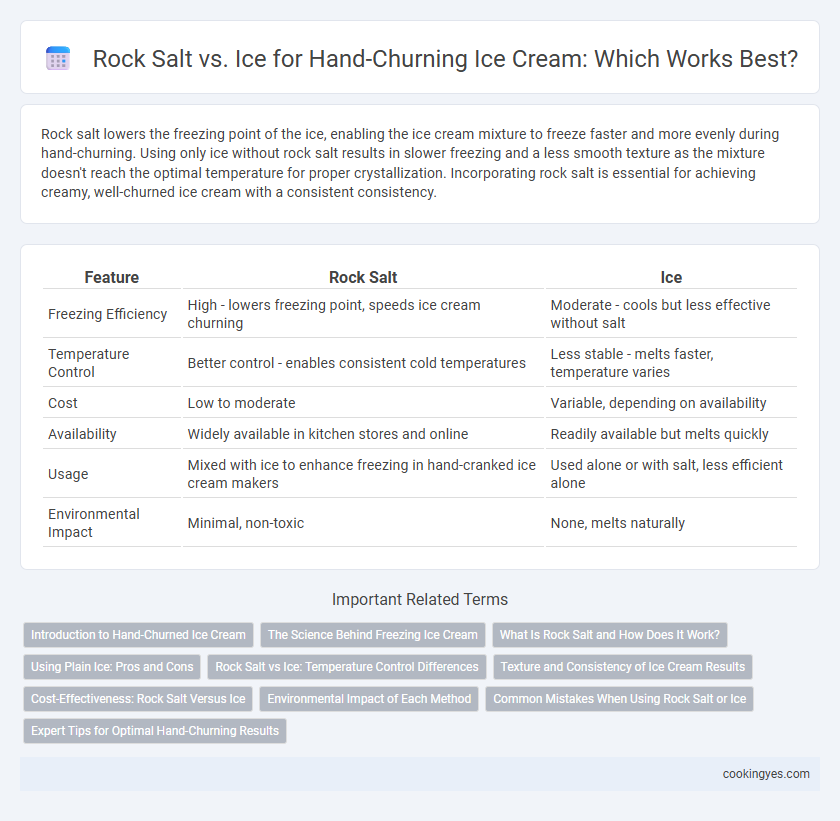Rock salt lowers the freezing point of the ice, enabling the ice cream mixture to freeze faster and more evenly during hand-churning. Using only ice without rock salt results in slower freezing and a less smooth texture as the mixture doesn't reach the optimal temperature for proper crystallization. Incorporating rock salt is essential for achieving creamy, well-churned ice cream with a consistent consistency.
Table of Comparison
| Feature | Rock Salt | Ice |
|---|---|---|
| Freezing Efficiency | High - lowers freezing point, speeds ice cream churning | Moderate - cools but less effective without salt |
| Temperature Control | Better control - enables consistent cold temperatures | Less stable - melts faster, temperature varies |
| Cost | Low to moderate | Variable, depending on availability |
| Availability | Widely available in kitchen stores and online | Readily available but melts quickly |
| Usage | Mixed with ice to enhance freezing in hand-cranked ice cream makers | Used alone or with salt, less efficient alone |
| Environmental Impact | Minimal, non-toxic | None, melts naturally |
Introduction to Hand-Churned Ice Cream
Hand-churning ice cream involves a simple mixture of cream, sugar, and flavorings churned in a container surrounded by a cooling agent. Rock salt lowers the freezing point of ice, creating a colder environment essential for freezing the ice cream mixture evenly. Using rock salt with ice in the hand-cranking process enhances the ice cream's texture by facilitating faster and more consistent cooling compared to ice alone.
The Science Behind Freezing Ice Cream
Rock salt lowers the freezing point of ice, creating a supercooled brine that absorbs heat from the ice cream mixture faster than plain ice, enabling quicker freezing. This rapid heat exchange promotes the formation of smaller ice crystals, resulting in smoother, creamier texture. Using rock salt in hand-churning ice cream enhances the efficiency of the freezing process by manipulating the freezing point depression principle.
What Is Rock Salt and How Does It Work?
Rock salt is coarse, unrefined salt commonly used to lower the freezing point of ice in hand-churning ice cream, creating a super-cold environment essential for proper freezing. When rock salt is added to ice, it dissolves and melts the ice slightly, absorbing heat and producing temperatures below 32degF (0degC), which accelerates the ice cream's solidification. This process, known as freezing point depression, enhances the texture and creaminess of homemade ice cream by ensuring even, rapid cooling during churning.
Using Plain Ice: Pros and Cons
Using plain ice in hand-churning ice cream offers easy availability and cost-efficiency, making it a practical choice for many home cooks. However, plain ice lacks the ability to lower the temperature as effectively as rock salt, which leads to longer freezing times and potentially less creamy texture. The absence of salt also means less control over melting rate, which can affect the consistency and smoothness of the finished ice cream.
Rock Salt vs Ice: Temperature Control Differences
Rock salt lowers the freezing point of ice, enabling the ice cream mixture to freeze faster and reach smoother, creamier textures by maintaining temperatures between -10degC and -20degC. Pure ice alone stabilizes around 0degC, which is insufficient for rapid freezing and results in coarser ice crystals within the ice cream. Effective temperature control through rock salt enhances the hand-churning process by promoting uniform freezing and reducing crystallization time.
Texture and Consistency of Ice Cream Results
Rock salt lowers the freezing point of ice, allowing the ice cream mixture to freeze faster and more evenly, resulting in a smoother and creamier texture with fewer ice crystals. Using just ice without rock salt often leads to slower freezing times and coarser, icier consistency due to uneven temperature distribution. The optimal hand-churning technique involves balancing the right amount of rock salt with ice to achieve consistent freezing and superior ice cream texture.
Cost-Effectiveness: Rock Salt Versus Ice
Rock salt is more cost-effective than ice for hand-churning ice cream because it lowers the ice's melting point, allowing the mixture to freeze faster using less ice overall. While ice alone requires a larger quantity to maintain the low temperature needed for freezing, rock salt enhances efficiency by enabling the use of smaller ice amounts and reducing total consumption. This results in significant savings over time, especially for frequent homemade ice cream makers.
Environmental Impact of Each Method
Rock salt lowers the freezing point more efficiently than plain ice, reducing the total amount of ice needed for hand-churning ice cream, which can lessen water consumption and energy used for ice production. Ice alone requires larger volumes and more frequent replenishment, increasing the environmental footprint through higher water and energy use. Using rock salt in moderation is environmentally favorable due to its ability to speed up ice cream freezing, minimizing both water waste and energy consumption during the churning process.
Common Mistakes When Using Rock Salt or Ice
Using too much rock salt during hand-churning ice cream can cause the mixture to become overly salty, while insufficient salt results in slower freezing and a less creamy texture. Common mistakes include mixing ice and rock salt in incorrect proportions, which disrupts the optimal freezing temperature needed for smooth ice cream consistency. Ensuring the proper balance of rock salt to ice is crucial for efficient heat transfer and achieving the desired frozen dessert texture.
Expert Tips for Optimal Hand-Churning Results
Rock salt is preferred over ice for hand-churning ice cream due to its ability to lower the freezing point more effectively, resulting in a faster and smoother freeze. Expert tips recommend using a 3:1 ratio of ice to rock salt to achieve optimal texture and consistency. Maintaining consistent shaking or turning during churning ensures even freezing and prevents ice crystal formation, delivering creamy, homemade ice cream perfection.
Rock salt vs Ice for hand-churning ice cream Infographic

 cookingyes.com
cookingyes.com